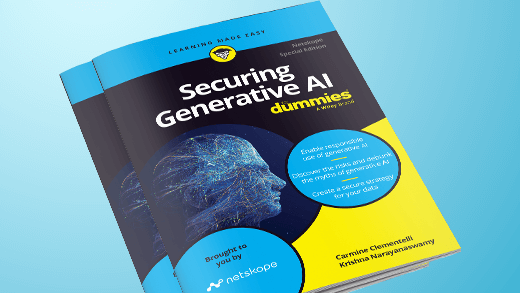Every year Verizon releases the Data Breach Investigations Report (DBIR), covering some of the biggest trends in data breaches across industries, highlighting the common causes for breaches as well as trendy attack vectors.
And every year, when it is released, my inbox is immediately hit with questions from colleagues and customers asking how Netskope can mitigate each of the issues raised. So this year I thought I would share my analysis more widely.
Human error
A major finding in this year’s DBIR report was the scale of issues caused by error; “error continues to be a dominant trend and is responsible for 13% of breaches” (in general, according to the report, 82% of breaches involved the human element).” In the case of errors, the report specifically cites cloud storage misconfigurations as the primary culprit (“This finding is heavily influenced by misconfigured cloud storage”).
One easy way to help keep human error in check, while keeping your sensitive data safe, is through Netskope Public Cloud Security, the Netskope solution for cloud security posture management (CSPM). CSPM uses security policies, monitoring capabilities, and automated and guided remediation tools in order to enforce established configurations and log any issues with those configurations. Continuous assessment helps to constantly keep an eye out for misconfigurations in your infrastructure, while automated remediation can help guide users to fix small misconfigurations before they become a bigger issue This way, you have a security function watching your back in case someone accidentally leaves a share setting a little bit too open.
Remote access
Another finding from the DBIR underscored the growing role that remote access is playing for attackers exploiting exposures. Desktop sharing software ranked among the top threat vectors highlighted in the report, including remote desktop protocol (RDP) and other third-party software that allows users to remotely access another computer over the internet. Unfortunately, if you can access the asset directly over the internet just using credentials, so can the attackers. The report even cites that desktop sharing software accounted for 40% of ransomware incidents that were analysed.
Netskope Private Access (NPA), the zero trust network access (ZTNA) solution in the Netskope Security Cloud, can help mitigate these remote access threats. NPA provides contextual, risk-based access to applications with the ability to monitor and protect data in third-party access situations. This is done by leveraging Netskope unified DLP controls and user entity behavior and anomaly (UEBA) detection to create contextual, adaptive access policies. It’s also worth noting that UEBA can be a helpful tool for recognising and mitigating the risk of internal incidents, which the DBIR noted was the cause of 20% of breaches. While the report notes that breaches caused by internal incidents are decreasing, that doesn’t take away the potency of their impact.
Vulnerability exploitation
The DBIR also outlines an opportunistic model for vulnerability exploitation that attackers are using, where they start their process by scanning for IPs and open ports as a way in. And while more security conscious companies attempt to keep these locked down, attackers often follow trails out to third-parties. While the report notes that this numbers game is often a fruitless effort for the malicious actors, just one success is enough to incentivise them to keep trying.
To keep these vulnerabilities locked down, a combination of Netskope Public Cloud Security (CSPM) and Netskope Private Access (NPA) will do the trick. CSPM to continuously monitor for and remediate any potential misconfigurations that attackers could exploit, and NPA to keep tabs on third-party users and make sure that no sensitive data is exfiltrated to suspicious sources.
Parallel thinking
There are also some findings in the DBIR that line up with some other topics and discoveries we have identified ourselves in the Netskope Threat Labs.
For example, the use of stolen credentials and phishing attacks plays an important role for system intrusions. The most common methods to steal credentials are phishing attacks or the exploitation of vulnerabilities on VPN concentrators or publicly-facing servers. This trend has become so common that you may have already heard about Initial Access Brokers. These are specific criminal groups who steal credentials and sell or outsource them to other criminal gangs. Netskope NG SWG can mitigate the risk of phishing attacks via threat intelligence (and integrations made possible by Cloud Exchange), and our DLP best practices. Additionally, switching to a zero trust paradigm can mitigate the risk of exploitation of vulnerabilities on VPN concentrators or publicly-facing servers or a compromised endpoint, for example by means of a phishing attack, accessing internal resources.
Finally, the DBIR observed a surge of malware delivered via Office docs, which is something we’ve noted before, but the timeframe of the DBIR analysis only ranges from November 1, 2020 to October 31, 2021, and since the beginning of 2022 the percentage of malicious Office docs has been decreasing. This is both because of the takedown of Emotet (which is now testing other distribution mechanisms) and because of additional protection measures applied by both Microsoft and Google for Office Docs. In any case, Netskope Threat Protection, a key component of the Next Gen Secure Web Gateway, has specific ML detectors for Office Docs which are a characteristic of our advanced threat protection engine that also include advanced heuristics, and a sandbox that is now able to map the tactics and techniques used by the attackers in the MITRE ATT&CK model.
The DBIR is always a hugely interesting and useful resource to security professionals looking to stay ahead of the attackers. My analysis here is just the tip of the iceberg, but hopefully it provides an idea of how the many capabilities in the Netskope Security Cloud can help mitigate these threats and keep your data and users safe.




 Back
Back 
















 ブログを読む
ブログを読む